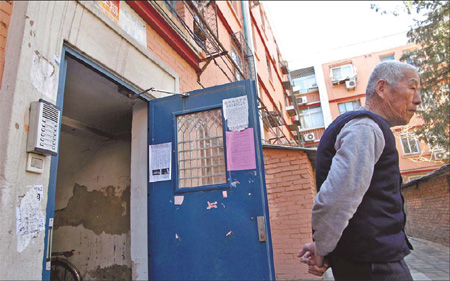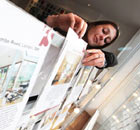Top Stories
Old homes to be renovated to withstand earthquakes
By Xu Fan (China Daily)
Updated: 2010-04-28 07:51
 |
Large Medium Small |
|
The safety of old houses such as this in Hepingli area has prompted concerns. [Wang Jing / China Daily] |
Beijing's housing authorities will renovate and reinforce many of the capital's one-story dwellings, most of which were not designed to withstand strong earthquakes, said local authorities.
Traditional-style courtyard housing and more modern-style one-story bungalows cover about 23 million sq m of urban and rural Beijing, accounting for almost 3.3 percent of the city's 700-million-sq-m of housing, according to the Beijing Municipal Commission of Housing and Urban-Rural Development.
"Most of the older modern bungalows are masonry and timber structures," said Li Zhiqiang, section chief with the housing safety and equipment administration office of the commission.
"Such bungalows were built before the Tangshan earthquake, when there were no regulations to ensure buildings could withstand seismic events," he said.
The 7.8-magnitude earthquake hit Tangshan in Hebei province in 1976 and prompted authorities to designate a seismic fortification intensity level, ranging from six to nine, for the entire country.
The fortification intensity level for the capital is eight and most construction here since the 1980s meets this standard, according to Li.
But residents living in old one-story buildings shouldn't worry too much in the interim as the commission makes housing safety checks every six months.
"The checks are not only for earthquake resistance, but also for all kinds of potential risks," he said.
Li said the checks involve two steps, if there are problems. In the first, the authorities examine the exteriors of old buildings and in the second construction engineers closely evaluate any potential problems found in the first step.
"Our staff check to see if the bungalows' walls have cracks or if the houses are tilting. Most problems are revealed through the initial exterior check," Li said.
Residents say they are not frantically awaiting the renovations. Kang Hongqun, 60, who lives in an old courtyard house in Dongcheng district, told METRO she and her neighbors were not worried about earthquakes and that her one-story residence was relatively safe.
"Most of the roofs on the old courtyard homes are made of wood, which is probably less likely to collapse under pressure than many other construction materials used in Beijing buildings, even if an earthquake happened," she said. "Most courtyard house residents are more concerned about rain seepage problems."
New apartment buildings and villas, which meet the earthquake resistance standards, are not included in the checks, according to the commission.
"Buildings that meet fortification intensity level eight should be able to withstand a magnitude 6 to magnitude 7 earthquake," said Liu Hang, senior engineer with the Beijing Building Construction Research Institute.
Property management companies running residential communities must have at least one qualified employee to look after housing safety in the community and ensure that any housing that doesn't meet fortification intensity level eight is reinforced quickly so that it does.








